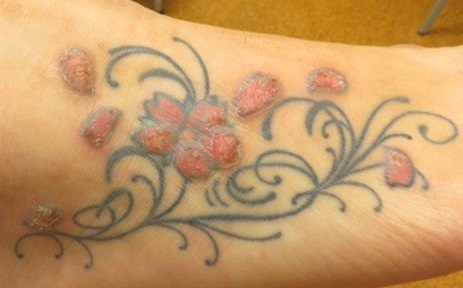The detrimental side effects of tattoos are known but are often being ignored. Many just assume that tattooing is safe because of its popularity. Others simply fail to do their research before being injected with dies, plastics, and paints. Many feel that since tattoo parlors are regulated, then the ink should be too, but that’s just not true. The potential for infection with life-changing infections is also present. The biggest health risk is due to heavy metal poisoning due to tattoo ink. There are things everyone should know before they are tattooed. I will endeavor to inform you of the major risks. Tattoos – Your health is at risk
Risks
The risks associated with tattooing are skin-related diseases, end-organ disease (liver, kidney, brain) and heavy metal poisoning. Although, there are ways to avoid these effects of tattooing and I will share those with you. But first, let’s look at some statistics.

According to Statistic Brain (2016),
- Americans spend a whopping 1.655 Billion dollars on tattoos annually.
- Americans that have at least one tattoo totals 45 Million people.
- The percentage of people who regret getting a tattoo is 17%.
- The percentage of Americans getting a tattoo removed is 11%.
Why are People Getting Tattoos?
These statistics are staggering numbers to me. It is surprising that that many people want to risk their health for skin art. But, people are motivated to get tattoos for a variety of reasons. The reasons ranging from wearing art on their skin, remembering a loved one or looking sexy or dangerous. The motivation is unimportant for today’s topic, but I just wanted to give you a little background.
The Dangers of Tattoo Ink Carriers
What are the dangers of tattoo ink carriers? Carriers are used to keep the ink, plastic or paint evenly distributed during application and inhibits the growth of pathogens (bacteria/viruses). Please understand that these ingredients are not regulated for use in tattooing by the Federal Drug Administration (FDA) in most states.

Carriers
- Ethyl Alcohol – rubbing alcohol is for use externally and should not be injected into the skin. Because it can cause skin drying, irritation and can negatively affect nerves.
- Glycerin – it is the sugar alcohol glycerol and can cause increased urination and diarrhea.
- Listerine – is an alcohol-based concoction of menthol, methyl salicylate, thymol (from thyme oil), and eucalyptol (liquid derived from eucalyptus oil). As a result, it can cause skin irritation and localized allergic reactions.
- Propylene Glycol – is the primary ingredient in antifreeze which can be damaging to your liver and kidneys.
The Dangers of Tattoo Ink
That was just the carriers. So, what is in each color of ink? Many of these inks have ingredients that you shouldn’t even apply to the skin, much less inject into the blood rick lower layer of skin. The epidermis is the outer layer of skin that is made up of dead skin cells that act as a whole-body bandage. It protects us from bacteria and viruses. The dermis is the living skin underneath the epidermis. Things injected into the dermis can be carried away by the bloodstream to all parts of the body. That’s why we get infections when we have a cut or scrape of our skin. Damage to the protective epidermis.
What is in the Ink?
Most inks contain acrylic resin (plastic molecules), but they also contain other ingredients. They are listed below by color as per Helmenstine (2017) and my own research.
Black ink
Iron oxide (rust), charcoal or carbon – this is probably the least dangerous ink. The amount of Iron oxide should be inadequate to cause iron toxicity. But, ask the tattoo artist to use purified water as a carrier.
Blue Ink
Copper, carbonite (azurite), sodium aluminum silicate (lapis lazuli), calcium copper silicate (Egyptian blue), cobalt aluminum oxides and chromium oxides. Copper can lead or contribute to heavy metal poisoning. Aluminum has been proven to contribute to Alzheimer’s disease, as well as, gastrointestinal disorders.
Brown ink
Iron oxide and iron ochre clay – this is probably as safe as black ink and for the same reasons.
Green ink
Chromium oxide and Malachite, lead chromate and the synthetic compound Cu phthalocyanine are used and only the first two are considered moderately safe. Lead chromate is from lead which is toxic even in low doses. Also, Cu phthalocyanine is an unregulated compound of copper and can cause skin irritation and respiratory irritation.
Orange ink
Disazodiarylide and/or disazopyrazolone, and cadmium sulfate make orange ink. The first two are considered safe, but the cadmium sulfate is considered toxic and possibly cancer-causing.
Purple
Manganese violet, quinacridone and dioxazine and the first of these are considered safe. Quinacridone is an FDA approved food coloring but has caused localized skin reactions.

Red
Cinnabar, cadmium red, iron oxide, and naphthol-AS pigment are the various components of red ink. So, it is considered by most to be the most toxic color of tattoo ink. Cinnabar is from mercury sulfate and is devastating to the nervous system. Consequently, Cadmium red is a
Yellow
Cadmium sulfate, Ochre, Curcuma yellow, chrome yellow and some are safe and others are not. Cadmium sulfate is from lead and is toxic. So, Yellow from the spice turmeric or Curcuma yellow is safe. The problem with yellow is the volume that must be used to provide a vibrant yellow color, so local irritation of the skin often occurs.
White
Titanium dioxide, lead white, barium sulfate and zinc oxide (the stuff you smear on your nose at the beach). Titanium dioxide has caused cancer in lab animals. So, lead white is considered a cancer-causing agent in humans. Barium is derived from the metal barium and is used in barium swallows for gastrointestinal tests, but when injected can cause skin irritation.

Glow in the dark ink
Made up of compounds that are toxic and in some cases radioactive. So, this again is unregulated in most states.
Safety of These Compounds
Some of these compounds can be considered safe, but testing still needs to be done. Some of these compounds are toxic and can cause heavy metal poisoning as the copper, lead, cadmium, chromium, arsenic and aluminum leach into your bloodstream. Aluminum inks can also hasten the onset of Alzheimer’s disease.
Some of these inks cause cancer and have known mutagenic properties (caused mutations and birth defects) per Genser (2007). The FDA should be regulating these inks, but in most states, they are not. So, the states have started regulating tattoo parlors though and at least that’s a start.
Tattoo Health Regulations
Regulation of tattoo parlors has greatly decreased the rate of serious infection. Also, the use of disposable needles has made a great impact too. In the past, in unregulated tattoo parlors, the risk for getting hepatitis B & C, HIV, tetanus, herpes, staph, and syphilis was a real threat. So, regulation and disposable one-use needles have eliminated this risk. As long as the regulations are followed.
Interference with Diagnostic Tests
One other major concern with tattoo art is the fact that lifesaving MRI scans cannot be done in certain instances. This is because the metals in the ink cause intense burning pain for the patient. So, this has prompted many radiology departments to refuse to perform MRI scans on patients with tattoos, per Grenser (2007). This could cause resulting misdiagnosis or the inability to diagnose due to severe pain experienced by the patient.

Carefully Select Your Ink
There are safe tattoo inks out there and artists that are willing to divulge their tattoo formulas. Also, there are many more that are dangerous tattoo inks that are unregulated. Consequently, many manufacturers refuse to divulge the formula as secret proprietary information. The carriers used to evenly distribute ink can also potentially be unsafe. Both the inks or carriers are not regulated by the FDA and regulation of tattoo art is the responsibility of each individual state.
Conclusion
Tattoo at your own risk. Also, tattoos can be safe or hazardous depending on your preparation for the tattoo. So, talk to the tattoo artist. Also, ask them what carrier solution they use. Ask them the composition of their ink. Choose your colors by which colors are least toxic. Make sure the tattoo artist’s shop has an active Health Department certificate. Also, ask them for their Health Department sanitation score. If you feel you must get a tattoo, please do your research and make an informed decision. I personally recommend that you don’t get a tattoo. Because there are just too many risks for minor irritations and lingering side effects like cancer, scaring, granulomas, infection, toxicity and infections, per Mishra (2013). I don’t think it’s worth the risk, but it’s your body. So, just please study-up and make an informed decision.
References
Statistic Brain. (Aug 13, 2016). Statistics Brain. In Tattoo Statistics. Retrieved7/19/2017, from http://www.statisticbrain.com/tattoo-statistics/.
Anne Marie Helmenstine, Ph.D. (Feb 20, 2017). Tattoo Ink Chemistry. InThoughtCo. Retrieved 7/19/17, from https://www.thoughtco.com/tattoo-ink-chemistry-606170.
Julie Genser. (Sep 28, 2007). The Truth About Tattoos: Health Risks, Toxicityand More. In Naturalnews.com. Retrieved 7/19/2017, from http://www.naturalnews.com/z022073_tattoos_health_skin.html.
Malabika Mishra. (Sep 27, 2013). 10 Adverse Side Effects of Permanent Tattoos. In List Crown. Retrieved 7/19/2017, from http://listcrown.com/10-adverse-side-effects-permanent-tattoos/.

